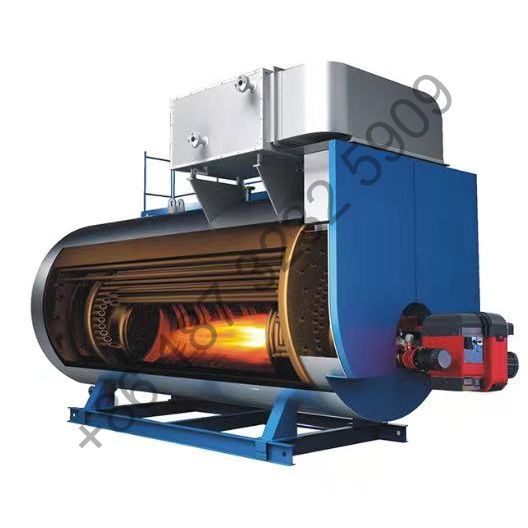The Beginner's Guide to Steam Boilers
Industrial steam boiler play a vital role in various industries, providing an efficient and reliable source of heat and power for a wide range of applications. From power generation to food processing, these boilers are indispensable in modern industrial processes. In this article, we'll delve into the intricacies of industrial steam boilers, exploring their types, components, operating principles, applications, and much more.

Industrial steam boilers are large vessels that produce and distribute steam to power machinery and equipment. They are essential in industries where high-temperature steam is required for various processes, such as power generation, heating, and sterilization. These boilers operate by converting water into steam through the application of heat generated by burning fuels or through electric heating elements.
Types of Industrial Steam Boilers
Fire Tube Boilers
Fire tube boilers utilize a network of tubes to transfer heat from the combustion process to the water surrounding them. They are commonly used in applications where rapid steam production is required, such as in small-scale industrial settings.
Water Tube Boilers
Water tube boilers feature tubes filled with water, which are heated externally by combustion gases. They are preferred in high-pressure applications due to their ability to withstand greater stress and produce higher-quality steam.
Electric Boilers
Electric boilers use electricity to generate steam, making them cleaner and more environmentally friendly than their fuel-fired counterparts. They are suitable for applications where emissions must be minimized.
Hybrid Boilers
Hybrid boilers combine the features of both fire tube and water tube boilers, offering flexibility and efficiency in various industrial settings.
Components of Industrial Steam Boilers
Industrial steam boilers consist of several key components, each playing a crucial role in the generation and distribution of steam.
Boiler Shell
The boiler shell provides a protective housing for the boiler components and contains the water and steam during the heating process.
Burner
The burner is responsible for igniting the fuel and generating heat, which is transferred to the water or tubes within the boiler.
Combustion Chamber
The combustion chamber is where the fuel is burned, producing hot gases that heat the surrounding water or tubes.
Heat Exchanger
The heat exchanger facilitates the transfer of heat from the combustion gases to the water, generating steam in the process.
Control Systems
Control systems regulate various aspects of the boiler operation, including fuel flow, combustion air intake, and steam pressure, ensuring optimal performance and safety.
Operating Principles of Industrial Steam Boilers
Industrial steam boilers operate on the principle of heat transfer, where heat energy is transferred from the combustion process to the water or tubes within the boiler, resulting in the generation of steam. This steam is then distributed to various parts of the industrial process, where it performs heating, mechanical work, or other functions as required.
Applications of Industrial Steam Boilers
Industrial electric steam generator find application in a wide range of industries and processes, including:
Power generation in thermal power plants
Heating and hot water supply in commercial and residential buildings
Food processing, including sterilization and cooking
Textile manufacturing, for dyeing and drying operations
Chemical and petrochemical industries, for steam-driven processes
Factors Influencing Boiler Efficiency
Several factors affect the efficiency of industrial steam boilers, including:
Fuel type and quality, with cleaner fuels generally resulting in higher efficiency
Boiler design and size, optimizing the combustion process and heat transfer
Maintenance practices, ensuring the proper functioning of all components and minimizing energy losses
Environmental Impact of Industrial Steam Boilers
Efforts to mitigate the environmental impact of industrial steam boilers include the adoption of emissions control technologies, such as selective catalytic reduction (SCR) and flue gas desulfurization (FGD), as well as the promotion of renewable energy sources, such as biomass and solar thermal.
Safety Measures and Regulations
Safety is paramount in the operation of industrial steam boilers, with stringent regulations and standards governing their design, installation, and operation. Compliance with codes such as the ASME Boiler and Pressure Vessel Code ensures the safe and reliable operation of boilers in industrial settings.
Maintenance and Troubleshooting
Regular maintenance is essential for ensuring the optimal performance and longevity of industrial steam boilers. Routine tasks include cleaning, inspection, and calibration of boiler components, while troubleshooting involves diagnosing and addressing common issues such as leaks, corrosion, and pressure fluctuations.
Advancements in Industrial Steam Boiler Technology
Recent advancements in industrial steam boiler technology have focused on improving efficiency, reducing emissions, and enhancing integration with renewable energy sources. Innovations such as advanced combustion controls, heat recovery systems, and biomass co-firing have contributed to significant improvements in boiler performance and sustainability.
Future Outlook for Industrial Steam Boilers
The future of industrial steam boilers looks promising, with continued growth expected in key end-user industries such as power generation, chemical processing, and food manufacturing. Technological advancements, coupled with increasing emphasis on sustainability and energy efficiency, are likely to drive further innovation in boiler design and operation.
Conclusion
Industrial steam boilers play a crucial role in powering industries worldwide, providing a reliable and efficient source of heat and power for a wide range of applications. With advancements in technology and a growing focus on sustainability, these boilers are poised to remain indispensable in the industrial landscape for years to come.

Comments
0